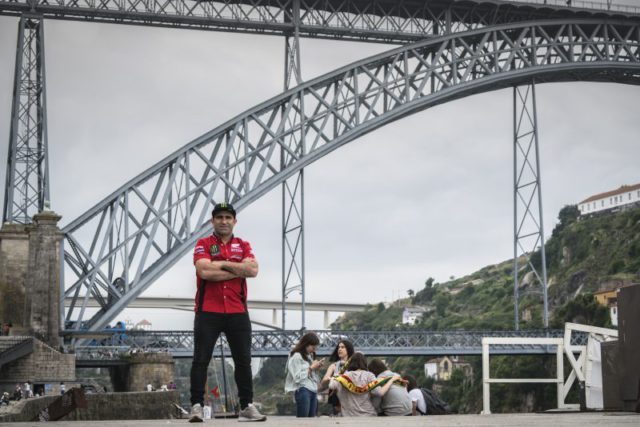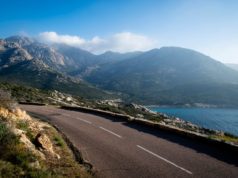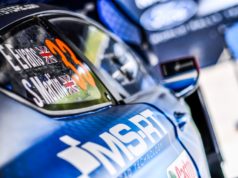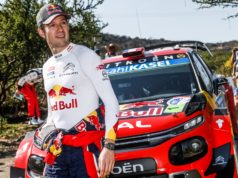Monster Energy Honda Team’s Portuguese rider is back and fired up. Absent from the 2018 Dakar after an accident during one of the final training sessions before the great challenge got underway, Paulo Gonçalves is now all set to make his comeback, with all the vigour that is so characteristic of the Portuguese ace.
The dark days are over for Paulo Gonçalves, giving way to a period of full recovery. The rider could soon recover the status that, at the end of last season, had him considered ‘favourite for everything’. Positive airs blow in northern Portugal and walking around the banks of the Douro, gives the chance for an interesting and intimate conversation with ‘Speedy’ Gonçalves.
– After missing the most recent Dakar 2018 due to injury and returning to action in March at less than 100%, the vital first question is: what kind of physical shape is Paulo Gonçalves in?
– Right now I am recovered and working hard for the races that we have scheduled for August in South America. What happened last December was very hard. I had very good feelings for the Dakar and … what happened really shouldn’t have: I hit a car in a training session and I injured my knee and shoulder, preventing me from being in the Dakar – the race that we had worked towards the entire season. It was really tough for me, but also for the team. We all suffered a lot, but we know that in this sport such accidents can happen. We do everything we can to try and avoid such dangers, but this time it was my turn.

– You were back in action at the Abu Dhabi Desert Challenge, at the end of March. How did you feel?
– Exactly. It was the first race after the injury and, despite all the difficulties, I think it went quite well. I finished fifth out of a list of participants which featured practically all the big names. I ended up quite satisfied, even though I knew I was at 30% of my abilities.
– Two weeks later you ran the Merzouga Rally…
– The first day there was a mess with the roadbook and I lost a lot of time, so I took that race for what it was, a training session, where it was also very important to have the other riders as references. It wasn’t so bad.
– It will be four months until your next race, the Atacama Rally. What have you been doing all this time?
– Mainly, getting my physical strength back which I lost with the injury. Right now I feel pretty good, comfortable and fit to face the forthcoming races to make it to the 2019 Dakar in the best shape possible, better than last year even. That is the goal. After what happened last December, I can think of nothing else. Six months to go and I have to take advantage to get stronger than ever. I need it for myself and my team.
– You were in Lima to prove how you were. Until the last moment, you tried to compete in the 2018 Dakar!
– I had the accident on December 18 and the checks were on January 4. I tried to recover as quickly as I could. In every possible way. I knew I needed a miracle to get into the race… It might have happened, but didn’t. It was not the moment. I tried and realized that whenever I touched a bit of sand, I ended up getting stuck as I was unable to pull the bike out. The start of the Dakar was much tougher than that, so it was a fairly clear decision. If I had had 20% good feelings, I would not have hesitated to start, but in this case, there was no doubt. Luckily HRC had a rider ready to use my bike in case I didn’t start. Realistically, I wouldn’t have lasted a day in the Dakar, plus, we had to look after the interests of the team too. I would have taken away the possibility of having a rider in the race to help his team-mates out…
– Now the next two World Championship dates are coming: the Atacama, in Chile and the Ruta 40, in Argentina. What are the sensations on returning to the World Championship?
– I will arrive in good shape from both the physical and the riding point of view, undoubtedly. But I am also clear that I can not make any mistakes that could compromise the work plan we have to reach the Dakar in the best way. We will have to fight for the top positions, but the important thing is to find a good pace. I am also aware that I can not afford to miss out on another Dakar due to a new injury. We must evaluate everything to do as well as possible without making mistakes that could compromise the future.
– The Dakar is six months away. You are strengthening muscles and building stamina. What is your working method right now?
– I am working physically with a personal trainer that I already had when I won the World Championship in 2013 and also in 2014 and when I finished second in the Dakar 2015. We are starting again and it is still very hard, but that just shows that we are working hard. Gym, bicycle, swimming and also something on the motorcycle. Whenever I can I train on the circuit, because it’s safer. The roadmap is this: a good physical plan and accumulation of kilometres on the bike.
– One part is the physical training of the rider, another is the bike set-up. How is the Honda CRF450 RALLY from the maturity point of view?
– Our bike, as far as durability is concerned, gives us a lot of guarantees. We haven’t had a mechanical problem in many races now. We are at a great level. But in our team, in HRC, we don’t stop improving. In this month of July we were testing in the United States to improve the weapons to fight in the races. The competitive level is very high.
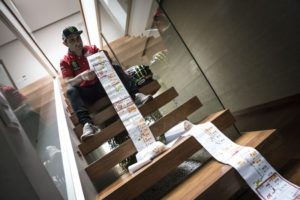
– What do you like most about the bike and what do you think can be improved on the Honda CRF450 RALLY?
– This bike is very well-balanced: it has a lot of power, stability, suspensions, the cycle part is great. I would like it to have more lows perhaps, but it is something that we have also tried with the engineers. We have found the best balance for the different types of terrains which we have to face in the races.
– The next Atacama will be practically all in sand. A good training ground for the 2019 Dakar, along with the Inca Challenge.
– For us, having a race with characteristics similar to the ones that we will find in the Dakar, is the best we can do. We can test the handling, how the bike takes the sand, durability, try it out in more difficult conditions, as well as our strength too. And in Atacama, which is held in Copiapó, we will have a difficult but positive race to get the sensations for the Dakar, similarly at the start of the Inca, in Peru.
– This year’s Dakar will only run in Peru. With a lot of sand and navigation …
– I do not know if it will be better or worse, it will be different, sure. It will be the first time that the Dakar takes place in one single country: it will be unprecedented in the race and it will be a challenge for everyone, not just for the riders, but also for the organization. And it will not be easy. In the past Dakar has seen many retirements, accidents … And that shows how the next Dakar will be. It will be as tough as always. The sand will be the main contender, so we’ll have to be very adaptable to those type of conditions to try to suffer as little as possible and still be the most competitive. We will find out in January…
– Ten stages, a marathon day… What else do you think you’ll find?
– There will definitely be six days of 100% dunes. I hope there is some mountain section so that people can recover a little. Because of the typology of the country, it is possible. The Dakar always feels good on a hard track.
– We are in the most beautiful places of Porto, your region. How is your country, your region.
– My region is very beautiful; it has everything you need to have a good quality of life: good weather, and also great tracks to enjoy with the motorbike, but also with the bicycle, as there are a lot of two-wheel fans around here. We have beaches, mountains… I am so privileged to have been born here in Portugal and, especially, in the north of the country.






















